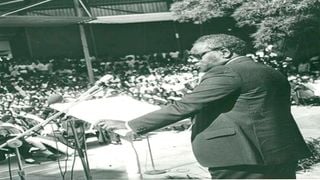
Then Vice President the late Josephat Karanja addresses students, parents and teachers of KTTC in 1988.
| File | Nation Media GroupNews
Premium
Museveni connection and the fall of Kenya’s fifth VP, Josephat Karanja
What you need to know:
- Josephat Karanja was aggressive and, perhaps, politically naïve with a vision blurred by hubris.
- One of the charges against Dr Karanja was that he had connections with Uganda’s Yoweri Museveni.
Once upon a time, President Daniel Arap Moi’s car developed mechanical problems near Gilgil. And as Moi, then Jomo Kenyatta’s vice-president, and his driver, struggled to fix the car, a diminutive Kenya Army technician surfaced from nowhere and offered to help.
Kuria Kanyingi was the name of the Good Samaritan. But as William Holden, American actor and former owner of Nanyuki’s Mt Kenya Safari Club, once said, “Hell is paved with good Samaritans” – and so was this.
What Kanyingi, perhaps, did not know was that he would later be used as a gladiator – as Moi tried to re-organise Mt Kenya politics to his own advantage.
When Kuria Kanyingi narrated this story, at the peak of his political career and to an attentive audience in his Limuru backyard, he wanted to showcase his grass to grace rise and how he came to loom like a giant shadow over central Kenya. At one point, or at that point, Kanyingi was the most important power broker in the Mt Kenya region – the sly fox that guarded the chickens.
As Kanyingi would later explain in 1984, he not only fixed the car but Moi had him transferred from the army to the Kenya Police where he was promoted to be the deputy director of the Motor Vehicle Inspection Unit, located in Nairobi’s Industrial Area.
The man who would first face Kanyingi’s ruthlessness, as he rose in politics, would be Moi’s vice-president, Dr Josephat Njuguna Karanja as a clique inside parliament led by Nicholas Biwott organised the rise of George Saitoti as Karanja’s replacement.
Some politicos argue that had hubris not taken part of Dr Karanja, he would – may be – have survived the intrigues that led to his resignation on the afternoon of Thursday, April 28, 1989.
But since his fall was scripted elsewhere – part of Moi’s desire to shape his survival and organise Mt Kenya politics – Dr Karanja had no chance when piranhas from his own backyard were let free.
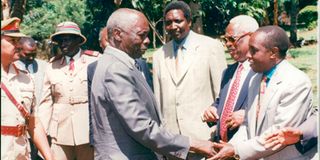
In this file picture, President Daniel Arap Moi is welcomed by Limuru Kanu sub-branch chairman Kuria Kanyingi at the Mbo-I-Kamiti company's offices.
So vanquished was Dr Karanja that by the time he died of cancer in Nairobi on February 28, 1994, his hopes of ever becoming president had vanished – and perhaps, as fast as he appeared on the political scene.
Dr Karanja’s rise was fast. He was aggressive and, perhaps, politically naïve with a vision blurred by hubris. He had taken his position with gusto – or as the Americans say, like a man on stilts and steroids. But when Kanu piranhas descended on him on Thursday April 28, 1989, he had no chance. The writing was already on the wall.
One of the charges against Dr Karanja – and like those facing Deputy President William Ruto today – was that he had connections with Uganda’s Yoweri Museveni and that he had received money from Uganda to import three million gunny bags from Bangladesh. He was also accused of soliciting money from Uganda to undermine President Moi.
History, at times, repeats itself.
When Kibaki was the vice-president, the Mt Kenya politics seemed to revolve around his personality. But in 1988, he was accused by the Weekly Review of sponsoring his own candidates in the region with a hint that he might be dropped as vice–president after the controversial General Election. While an attempt was made to rig Kibaki out, he was, as predicted, demoted to Minister for Health as Dr Karanja took his place.
Dr Karanja, a former University of Nairobi vice-chancellor, was a political tyro and had only been in Parliament for just 16 months. Unlike Jaramogi Oginga Odinga or Kibaki before him, Dr Karanja, like Joe Murumbi, had no political power base and, thus, was as easy to frustrate.
To win the attention of Mt Kenya politicians, Mr Kanyingi started with donating buses to women groups who were to buy shares in companies that had been set up.
All the while, he said he was not interested in politics. But politicians, journalists, and the clergy followed Mr Kanyingi – as the ‘development conscious leader’ and newsmaker. Although it was against the rules for civil servants to engage in politics, it was surprising when the junior civil servant took on the vice-president, ridiculed him in public and got away with it.
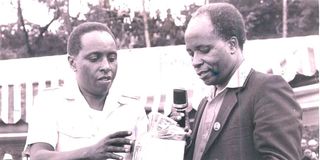
Mr Kuria Kanyingi (left), the then Director of the Motor Vehicle Inspection Unit, gives a donation of Sh300,850 to Transport and Communications Minister, Mr Joseph Kamotho, during a harambee meeting in Murang'a.
Looking back, Mr Kanyingi was the man to help Moi organise the Mt Kenya politics.
But Dr Karanja saw the forest for the trees. Before his fall as Moi’s vice-president, Dr Karanja had ignored the emergence of Mr Kanyingi as a loud-mouthed Nyayo crusader; the man with loads of unexplained cash.
Mr Kanyingi, as corrupt as he was, targeted churches and women groups with his unending supply of money – and every weekend, at the state-broadcaster, a camera would be spared for him; just in case he had a function.
He thought that Kanyingi was working at the behest of Githunguri MP Arthur Magugu – mistake number one. As a result, he made the mistake of trying to end Magugu’s political career in Githunguri and had on January 25, 1989 rallied some Kanu officials in Githunguri to pass a vote of no confidence in him. A meeting called by Mr Magugu on January 29 ended up with constant heckling. By doing so, Dr Karanja had touched a live wire – since Magugu was no pushover.
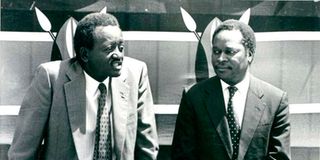
Commerce Minister Arthur Magugu (left) chats with Kerio South MP Nicholas Biwott after attending a Kanu meeting at KICC in 1992.
That was when Mr Kanyingi came up with the allegations that there was a kneel-before-me politician who was undermining the president. The party headquarters reacted swiftly condemning the unnamed politician with James Njiru, the Minister for National Guidance and Political Affairs and Oloo Aringo, the Kanu secretary-general, promising to issue a statement once they receive complaints from Kiambu.
In another rally held in Kiambu on March 9, Mr Kanyingi and the Limuru MP Samuel Mwaura, brought in a Mercedes Benz, registration KZF 645, which had been smashed from behind. They told the rally that there was an assassination attempt on the MP as he came back from Kabarak, Moi’s residence. Mr Kanyingi also claimed he had escaped another attempt on his life on his way to Kabarak for a harambee.
By the time Embakasi MP David Mwenje brought the matter to Parliament on April 25, 1989 and tabled a motion to have the conduct of the vice-president and Leader of Government Business discussed, the ground had already been poisoned. Part of the accusation was that he had elevated himself as acting President when Moi was out of the country.
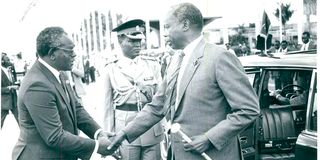
In this file picture Vice President Dr Josephat Karanja bids farewell to President Daniel Arap Moi at the Jomo Kenyatta International Airport.
Mwenje was a rabble-rouser with a short-man syndrome or what political scientist call Napoleon Complex – a condition where short men try to overcompensate it with excessive aggression towards their target.
As members started the debate, Dr Karanja, isolated by everyone, apart from Starehe MP Kiruhi Kimondo, sat on the front row taking notes on what the speakers were saying about him. His attempt to offer a defence was constantly met with heckling.
“We do not want trouble. We do not want chaos. Our loyalty to the president is direct, right from our houses, from our constituencies to the President,” said Mwenje.
On April 26, 1989 – after realising that his goose was cooked – Dr Karanja invoked Standing Order No 69 and sought to address the House. It was a personal statement – powerful and to the point.
“In view of what transpired here in the House yesterday, when the member for Embakasi mentioned my name, I wish to make a personal statement. This is a sad day for our beloved country. Common decency has been thrown out of the window. It has regrettably been replaced by political thuggery and vindictiveness. The so-called charges against me are totally false and malicious, tendentious and contemptuous.”
But Dr Robert Ouko, then Minister for Foreign Affairs told off Dr Karanja telling him there was nothing sad about the day and asked the VP to explain his side of the story saying the House would not follow magendo (corrupt) leaders. (Eight months later, Dr Ouko was dead – thanks to the same system he was defending).
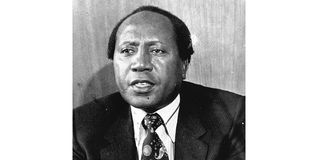
Former Minister for Foreign Affairs, the late Dr Robert Ouko.
A week after Parliament voted against him, the Nairobi Kanu branch expelled him from the party and on May 5, he resigned as MP after a two-month saga.
Politicians never learn. While Moi managed to use politicians from Mt Kenya region to end Dr Karanja’s career, the same politicians would be dropped later on. Mr Kanyingi would later oust Mr Mwaura (the man who had displayed a Mercedes Benz) as the Limuru Kanu sub-branch chairman. And Magugu would face the same wrath in 1995 when Mr Kanyingi took over the Kiambu branch chairmanship.
The only payback was that Dr Karanja ran against Magugu and won the Githunguri seat in the December 1992 elections where he polled 34,019 while Mr Magugu got 4,498.
Kanyingi tried to get the Limuru seat in 1992, when he ran on a Kanu ticket against architect George Nyanja. But he fared badly. But despite his dismal education, Kanyingi was appointed the chairman of Kenya National Trading Corporation (KNTC), until July 1994. KNTC was then the playground of sugar barons.
It later emerged that Mr Kanyingi had grabbed 90 acres of Kenya Agriculture Research Institute’s potato research centre farm in Tigoni, Kiambu, and when he was confronted by Kari – after workers pulled down Kanyingi’s fences – he gave back 70 acres and retained 20. (This has since been recovered).
In 1999, the Public Accounts Committee had recommended that Kanyingi be surcharged, together with five other directors, for the loss of Sh301 million at KNTC.
As it would emerge later, Mr Kanyingi was a staunch supporter of Prof Saitoti and whether this had to do with the war he had set on Dr Karanja is never clear. But in politics, anything can happen. Saitoti would also face similar trials and was once poisoned.
By 1997, it was Kanyingi and Magugu who were openly complaining that the elite Central Province Development Group (CPSDG) was misleading President Moi.
At one point, Mr Magugu described CPSDG members as a “bunch of opportunists who have already acquired or are trying to acquire public utility plots, forests or government contracts.”
He was right. Members of this group claimed to be popularising Kanu in central Kenya and blamed Mr Kanyingi for high-handedness, which led to the eclipsing of the party in 1992. They were also right.
In politics, the forest may be different – but same monkey tactics. The monkeys are back…
[email protected] @Johnkamau1





